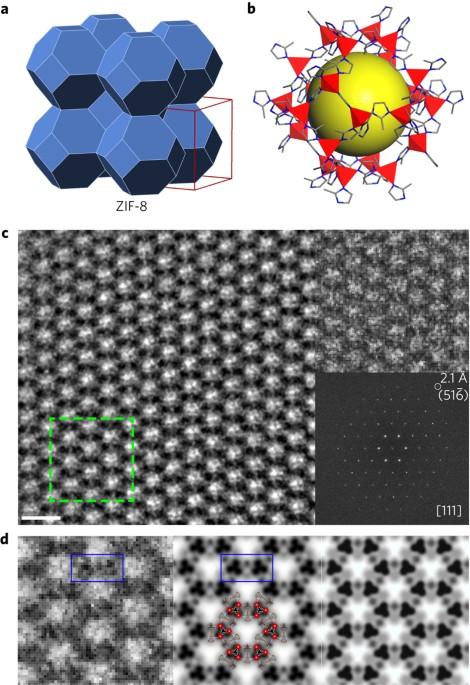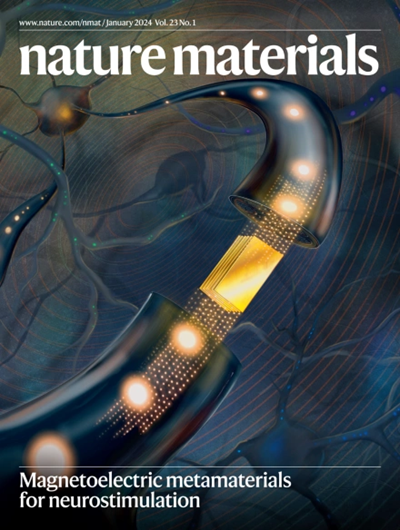Unravelling surface and interfacial structures of a metal–organic framework by transmission electron microscopy
IF 38.5
1区 材料科学
Q1 CHEMISTRY, PHYSICAL
引用次数: 255
Abstract
The operational conditions used for electron microscopy can limit the insight that can be gained from fragile material samples. It is shown here how high-resolution TEM analysis of delicate MOFs can be achieved. Metal–organic frameworks (MOFs) are crystalline porous materials with designable topology, porosity and functionality, having promising applications in gas storage and separation, ion conduction and catalysis1,2,3. It is challenging to observe MOFs with transmission electron microscopy (TEM) due to the extreme instability of MOFs upon electron beam irradiation4,5,6,7. Here, we use a direct-detection electron-counting camera to acquire TEM images of the MOF ZIF-8 with an ultralow dose of 4.1 electrons per square ångström to retain the structural integrity. The obtained image involves structural information transferred up to 2.1 Å, allowing the resolution of individual atomic columns of Zn and organic linkers in the framework. Furthermore, TEM reveals important local structural features of ZIF-8 crystals that cannot be identified by diffraction techniques, including armchair-type surface terminations and coherent interfaces between assembled crystals. These observations allow us to understand how ZIF-8 crystals self-assemble and the subsequent influence of interfacial cavities on mass transport of guest molecules.

通过透射电子显微镜揭示金属有机框架的表面和界面结构。
电子显微镜的操作条件会限制从脆弱材料样品中获得的洞察力。本文展示了如何对脆弱的 MOFs 进行高分辨率 TEM 分析。金属有机框架(MOFs)是一种晶体多孔材料,具有可设计的拓扑结构、孔隙率和功能性,在气体储存和分离、离子传导和催化等方面具有广阔的应用前景1,2,3。由于 MOFs 在电子束辐照下极不稳定,因此用透射电子显微镜(TEM)观察 MOFs 极具挑战性4,5,6,7。在此,我们使用直接探测电子计数相机,以每平方英寸 4.1 个电子的超低剂量获取 MOF ZIF-8 的 TEM 图像,以保持其结构的完整性。所获得的图像涉及的结构信息可传输到 2.1 Å,从而可以分辨出框架中锌和有机连接体的单个原子列。此外,TEM 还揭示了衍射技术无法识别的 ZIF-8 晶体的重要局部结构特征,包括扶手椅型表面端点和组装晶体之间的相干界面。通过这些观察,我们可以了解 ZIF-8 晶体是如何自组装的,以及界面空腔对客体分子质量传输的影响。
本文章由计算机程序翻译,如有差异,请以英文原文为准。
求助全文
约1分钟内获得全文
求助全文
来源期刊

Nature Materials
工程技术-材料科学:综合
CiteScore
62.20
自引率
0.70%
发文量
221
审稿时长
3.2 months
期刊介绍:
Nature Materials is a monthly multi-disciplinary journal aimed at bringing together cutting-edge research across the entire spectrum of materials science and engineering. It covers all applied and fundamental aspects of the synthesis/processing, structure/composition, properties, and performance of materials. The journal recognizes that materials research has an increasing impact on classical disciplines such as physics, chemistry, and biology.
Additionally, Nature Materials provides a forum for the development of a common identity among materials scientists and encourages interdisciplinary collaboration. It takes an integrated and balanced approach to all areas of materials research, fostering the exchange of ideas between scientists involved in different disciplines.
Nature Materials is an invaluable resource for scientists in academia and industry who are active in discovering and developing materials and materials-related concepts. It offers engaging and informative papers of exceptional significance and quality, with the aim of influencing the development of society in the future.
 求助内容:
求助内容: 应助结果提醒方式:
应助结果提醒方式:


